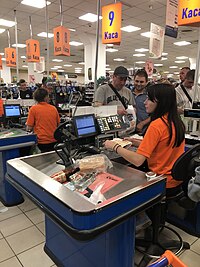
Photo from wikipedia
Abstract Purpose Assistive and rehabilitation devices are dependent upon detecting the user intent through physiological and kinematics changes. Rising from a chair and vice-versa have been less investigated for the… Click to show full abstract
Abstract Purpose Assistive and rehabilitation devices are dependent upon detecting the user intent through physiological and kinematics changes. Rising from a chair and vice-versa have been less investigated for the purpose of rehabilitation-aids. This study investigates the muscle activation along with trunk and knee biomechanics in sagittal plane during sit-to-stand and stand-to-sit transfer. Method Nine healthy participants (age 25.67 ± 3.27 years) were measured for flexion/extension of knee and trunk, and for surface electromyography (EMG) of vastus lateralis (VL) and biceps femoris (BF) of both the legs at a speed of 100 beats per minute while performing sit-to-stand and stand-to-sit task. Results The knee flexion angles at peak EMG-RMS (root mean square envelope of EMG) were significantly different for the two tasks (p = 0.002). Also, for each muscle, EMG-RMS peak was obtained at significantly different knee angle within the same task (p = 0.046). EMG work done (WD) was also found to be significantly different for the intervened muscles (p = 0.002). Conclusions Trunk flexion together with VL showed an earlier onset in sit-to-stand task, which might form an important modality for detecting human intention to perform the activity. However, for stand-to-sit task, some other muscle group in conjunction to BF may be useful for detecting the human intention. The understanding from the study could be used as a first step in devising multimodal control for assistive devices aiding sit-to-stand and stand-to-sit transfers. That would be a novel approach to fuse the data of postural deviation into the EMG signal to achieve lower limb rehabilitation or in prosthetic control. Implications for rehabilitation Multi-modal sensor fusion can be used for realtime monitoring of patient biomechanics. Development of control algorithms for assistive devices aiding sit-stand transfers. Sensor fusion will help in achieving greater robotic compliance rehabilitation.
Journal Title: Disability and Rehabilitation: Assistive Technology
Year Published: 2019
Link to full text (if available)
Share on Social Media: Sign Up to like & get
recommendations!